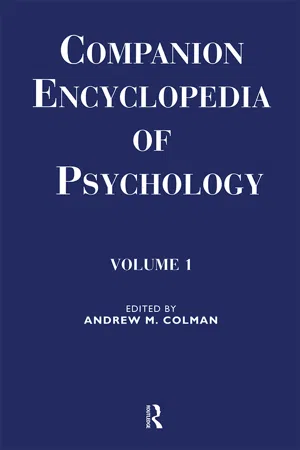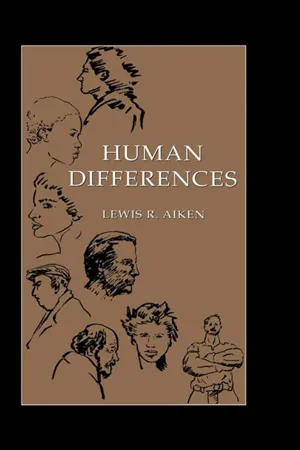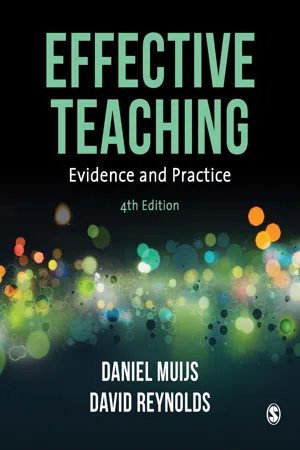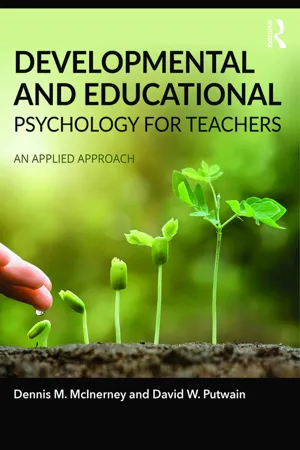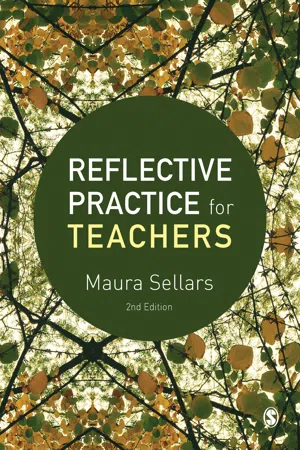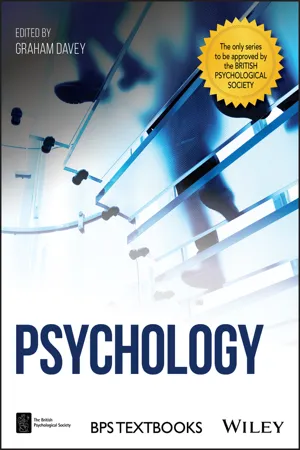Psychology
Theories of Intelligence
Theories of intelligence in psychology encompass various perspectives on the nature of intelligence and how it can be measured. These theories include the psychometric approach, which focuses on quantifying intelligence through standardized tests, and the cognitive approach, which emphasizes problem-solving and information processing abilities. Additionally, the multiple intelligences theory proposes that intelligence is composed of distinct modalities, such as linguistic, logical-mathematical, and spatial abilities.
Written by Perlego with AI-assistance
Related key terms
Related key terms
1 of 4
Related key terms
1 of 3
10 Key excerpts on "Theories of Intelligence"
- eBook - ePub
Companion Encyclopedia of Psychology
Volume One
- Andrew M. Colman(Author)
- 2018(Publication Date)
- Routledge(Publisher)
Most theorists of abilities have argued that whatever the differences may be across cultures, there are at least some aspects of intelligence that are the same. Let us consider next what some of the major explicit Theories of Intelligence are.Explicit theorie
Explicit Theories of Intelligence are those proposed by psychologists (or others) and tested by comparing the theories' predictions to data collected from human subjects. Explicit theories can be of various kinds. We shall consider here psychometric, information-processing, biological, developmental, contextual or cultural, and systems theories.Psychometric theories
Psychometric theories are so-called because they are based on the measurement (-metric) of psychological (psycho-) properties. Usually, such theories are tested by the measurement of individual differences in people's psychological functioning. The individual-differences approach has people perform a large number of tasks that seem to predict intelligent performance (such as in school or on the job), including recognizing meanings of words, seeing verbal or figural analogies, classifying which of several words does not belong, solving simple arithmetic problems, completing series of numbers, or visualizing spatial relationships between abstract forms. The psychologist uses data from these and similar tasks to analyse patterns of individual differences in task performance. These patterns have usually been statistically analysed through the use of a method called factor analysis. The idea is to identify the basic underlying factors of human intelligence.The earliest factorial theory of the nature of human intelligence was formulated by Spearman, who also invented factor analysis. His theory is called the two-factor theory. Spearman (1927) suggested that intelligence comprises two kinds of factors-a general factor and specific factors. General ability, or g, - eBook - ePub
- Lewis R. Aiken(Author)
- 2014(Publication Date)
- Psychology Press(Publisher)
However, as in attempting to solve any complex problem, the path toward answers to research questions meanders and often goes backward rather than forward. A well thought-out theory, based on meaningful concepts, logic, and prior research findings, can often assist in predicting and understanding behavior, but there is no guarantee that it will actually do so. Furthermore, because they are human, theorists may be reluctant to abandon hypotheses in which they have invested their time, energies, and egos even when their speculations fail to be verified by experience and experiment. For this and other reasons, many of the Theories of Intelligence that were fashionable during the late 19th and early 20th centuries and have not stood the test of time are still around today in one form or another. It can be argued that more important than whether a theory is right or wrong is whether it is useful or nonuseful. For example, many conceptions of intelligence as a conglomeration of factors or special abilities (e.g., Cattell, 1963; Guilford, 1967; Spearman, 1927; Thurstone, 1938; P. E. Vernon, 1960) are not absolutely correct in the sense of providing an accurate understanding of the structure of intellect. Nevertheless, they have been heuristic in their role of suggesting ideas and promoting further research. These psychometric theories or models stemmed from empirical/statistical demonstrations that scores on a large number of people on a sizable number of tests could be condensed into a smaller number of factors or traits. Spearman (1927) described intelligence in terms of a general factor (g), plus several specific factors. Thurstone (1938) characterized intelligence as a composite of seven primary mental abilities - eBook - ePub
Cross-Cultural Psychology
Critical Thinking and Contemporary Applications, Sixth Edition
- Eric B. Shiraev, David A. Levy(Authors)
- 2016(Publication Date)
- Routledge(Publisher)
- Most definitions of intelligence include phrases such as knowing and understanding the reality around us. Intelligence is also defined as a set of mental skills that helps individuals reach a goal. Intelligence is also seen as the ability to use knowledge and skills to overcome obstacles. And, finally, intelligence is defined as helping one to adapt to a changing environment.
- Intelligence is inseparable from cognition, diversified processes by which the individual acquires and applies knowledge. It usually includes processes such as recognition, categorization, thinking, and memory. Altogether, cognitive development is neither totally culturally relative nor completely uniform everywhere.
- In psychology, most attention has been given to the so-called psychometric approach to intelligence. This view is based on the assumption that our intelligence can “receive” a numerical value.
- Today various tests show differences in intelligence scores among large cultural groups. For example, in the United States, Asian Americans (of East Asian origins) score the highest, followed by European Americans, Hispanics, and, lastly, African Americans. Thus, on the average, African American schoolchildren score 10–15 percent lower on a standardized intelligence test than white schoolchildren.
- In an attempt to explain some group differences on intelligence test scores, Sternberg suggested distinguishing between intelligence and intelligent behavior. Intelligence, from his standpoint, is a mental process that may or may not result in particular behavioral patterns. These patterns of intelligent behavior may vary from culture to culture. Something considered to be intelligent among members of one culture may not be viewed as such in other cultures.
- According to the nativist approach to intelligence, human cognitive phenomena are inborn. They unravel as a result of biological “programming,” and environmental perception requires little active construction by the organism. There is evidence that heredity plays an important role in human intelligence. However, genetic links for individual differences and similarities do not imply that group differences—on the national level, for example—are also based on genetic factors.
- eBook - ePub
Effective Teaching
Evidence and Practice
- Daniel Muijs, David Reynolds(Authors)
- 2017(Publication Date)
- SAGE Publications Ltd(Publisher)
1 Theories of Learning and IntelligenceKey Points
In this chapter, you will learn about:- the main elements of behaviourist learning theory
- what Piaget and Vygotsky had to say about learning, and its relevance today
- the meaning of IQ and traditional theories on intelligence
- Gardner’s theory of multiple intelligences
- the main lessons from cognitive science.
Introduction
In this chapter, we will discuss the main theories on how children learn. This is of course an important issue in teaching, as to be effective we need to try and teach in a way that reinforces how people naturally learn. Theories of learning and intelligence are many and diverse, and we can’t look at all existing theories in one chapter. What we will do instead, is focus on some of the theories that have been most influential in education over the years.IQ Theory
One of the first theories on learning to gain widespread currency in education was IQ (Intelligence Quotient) theory.IQ theory is mainly interested in the concept of intelligence, which is seen as determining people’s ability to learn, to achieve academically and therefore to take on leading roles in society. IQ theorists, like William Stern, who was one of the developers of the theory in the early part of the twentieth century, claimed that core intelligence was innate. Many psychologists in the USA and Europe supported that conclusion and psychologists like Terman and Binet developed instruments specifically designed to test people’s innate intelligence. These were analysed using the newest statistical methods such as factor analysis, developed by Thurstone and Spearman. These analyses showed that all the items (questions) in those tests essentially measured one big factor, called G, or ‘general intelligence’. Therefore, the theory states that people have one underlying general intelligence, which will predict how well they are able to learn and perform at school (Howe, 1997). - eBook - ePub
Developmental and Educational Psychology for Teachers
An applied approach
- Dennis McInerney, David Putwain(Authors)
- 2016(Publication Date)
- Routledge(Publisher)
In this chapter we consider the psychometric appoach to intelligence. The psychometric approach is quite different from Piagetian and Vygotskian perspectives as the emphasis is one of measuring the intellectual capacity of individuals relative to others of the same age. It seeks to define and quantify dimensions of intelligence, primarily through the collection of data on individual differences and through the construction of reliable and valid mental tests (Chamorro-Premuzic, 2011; Chamorro-Premuzic & Furnham, 2008; Furnham et al., 2005). There is no attention given to the processes by which children become ‘intelligent’ which is the focus of both Piaget and Vygotsky.We also discuss some alternative theories that describe intelligence as multifaceted and finally we consider giftedness and creativity and relate these personal characteristics to conceptions of intellignece and intelligent behaviour. The following website provides further information on key themes covered in this chapter: http://intelltheory.com/index.shtmlPsychometrics and intelligenceWhile the issues of importance to Piaget related to the nature of, when, and how individuals acquired increasingly sophisticated capacities for thinking, and Vygotsky was most interested in the issue of the social construction of learning and the role it plays in individuals developing as thinkers and knowers, the issues of importance in the psychometric approach relate to designing measurements of intellectual capacity and whether such measurements can be used to predict later intellectual performance. The psychometric approach is also concerned with meaningfully comparing the intelligence of individuals, what factors make up intelligence, and whether these factors change with age? (De Ribaupierre & Lecerf, 2006; Shayer, 2008).QUESTION POINTAt this point it is useful to ask yourself to define intelligence. What do you understand by intelligence? How is it demonstrated? How does it develop? What is intelligent behaviour related to? - eBook - ePub
Intelligence
Reconceptualization and Measurement
- Helga A.H. Rowe(Author)
- 2013(Publication Date)
- Psychology Press(Publisher)
6Cognitive Developmental Perspectives on Intelligence1Susan R. Goldman James W. Pellegrino Vanderbilt UniversityThe construct intelligence has occupied a key position in psychology and in education from the very beginning of those fields. For almost as long, there has been disagreement and sometimes controversy over the definition of intelligence. With the exception of E. G. Boring’s (1923) operational definition of intelligence, namely that intelligence is what the tests test, no other single definition has emerged in the field, despite the existence of at least two major symposia designed to yield consensual definition. What emerged from those symposia, held 65 years apart in 1921 and 1986, were lists of attributes of intelligence (Sternberg & Detterman, 1986). Table 6.1 is a synthesis of the attributes generated at both points in time (Sternberg & Berg, 1986). In general, theorists in 1986 preferred a multidimensional, non-factorial view emphasizing general and specific knowledge and cognitive processes that are used within practical as well as academic venues (see Pellegrino & Goldman, 1990). Further examination of the two lists shows precious little in the way of consensual agreement about even the top ranked attribute, higher level processes: At the 1986 symposium, only 50% of the participants mentioned this attribute, down from 57% in 1921. The 1986 list included several attributes not included in the 1921 list, including what is valued by culture, process knowledge interaction, and automated performance. - eBook - ePub
- Maura Sellars(Author)
- 2017(Publication Date)
- SAGE Publications Ltd(Publisher)
6 Theories on the Nature of IntelligenceQ1 What do think about the nature of intelligence? Q2 Do you think intelligence can be changed or improved? Q3 Do you think that there are different types of intelligence? Q4 Do you think that intelligence is easily measured, or able to be measured at all?Introduction
The nature of intelligence has been a contentious issue for some decades, despite the existence of a very large number of definitions for this construct. Generally, intelligence is understood to be the human capacity to learn effectively. Originally the debate focused on the nature versus nurture argument, but currently, additional considerations have brought more complexity to the debate than before. What you think about the nature of intelligence itself underpins everything you do in your classroom. It determines what and how you prepare your teaching activities to support students’ learning, how you perceive and design students’ assessment tasks and how you actually interpret student progress and evidence of learning.What Does the Literature Say About Theories of Intelligence?
Binet has been credited with being the first psychologist to make a serious contribution to the understanding and measurement of intelligence (Anderson, 1999: xv). He was commissioned by the French at the end of the nineteenth century to devise some way of identifying children who would need extra educational support. Anderson (1999) concludes that Binet’s contribution to understanding intelligence is three-fold: his understanding of intelligence as higher order properties of the mind which has provided a challenge to Spearman’s theory of general intelligence, his formulation of the notion of ‘mental age’ and the fact that he later gave Piaget a job, which entailed him developing the Binet IQ tests. The notion that there is a single, biologically predetermined potential for intelligence which is unaffected by other, environmental factors is largely unacceptable in today’s educational contexts. This perception of intelligence has largely served the conservative, male, middle-class white population (Kincheloe, Steinberg and Villaverde, 1999: 1). Anderson (1999: 9) discusses Eysenck’s belief that many of the important aspects of intelligence will have to wait for the findings of neuroscience. However, Anderson himself contends that finding a precise neurological explanation for intelligence will not wholly explain or settle the current debates regarding the nature of intelligence. This is simply because of the other important environmental factors that are always variables. What is agreed, however, is that, for many theorists, intelligence is only what the intelligence tests are testing. Styles (1999: 23) discusses three ‘fundamental doctrines of human ability’ taken from Spearman and Jones (1950). She describes these as: - eBook - ePub
- Graham C. Davey(Author)
- 2018(Publication Date)
- Wiley(Publisher)
Think of all the terms that, in your opinion, define intelligence. Use a dictionary, if you want. Eliminate terms that have the same meaning as other words. Order the remaining terms in order of priority. Which term do you think is the most important in describing intelligence? Why?SECTION SUMMARY
- Psychological traits that differ between and within people are referred to as ‘dimensions of individual differences’.
- Intelligence affects a wide range of life outcomes, including achievement and health.
- Researchers have struggled to come up with a comprehensive consensus definition since the first scientific writings on intelligence, which date back to the 19th century.
- A consensus definition of intelligence was supported by 52 intelligence research experts in 1994. It emphasizes the ability to quickly comprehend and adapt to novel circumstances as a core aspect of intelligence but it excludes accumulated knowledge, experiences, and information.
HISTORY OF INTELLIGENCE
LEARNING OBJECTIVE 13.2
Describe the core advances in the history of intelligence research.The idea that people differ in their mental abilities pre-dates the Roman Empire, but the first scientific investigation into intelligence is attributed to the Spanish physician Juan Huarte de San Juan, who published Examen de ingenios para las sciencias (loosely translated as Examination of the Abilities for the Sciences) in 1575 (Fernández-Ballesteros & Colom, 2004). Complete records of Huarte’s works no longer exist but his ‘examen’ are considered to be the earliest scientific writings on intelligence, and in particular on testing intelligence.The influence of Francis GaltonIntelligence originated as a discipline of scientific study in England. It was inspired by Charles Darwin’s seminal publication On the Origin of Species - eBook - ePub
- Robert J. Sternberg(Author)
- 2014(Publication Date)
- Psychology Press(Publisher)
In summary, children’s beliefs about the malleability of intelligence may represent simple differences in emphasis or quite pervasive distinctions in understanding the components of intelligence and their interrelationships. In future research, it would be valuable to investigate how entity and incremental beliefs map on to larger conceptions of intelligence and how these beliefs develop. Regardless of the findings of this research, however, the fact remains that conceptions of intelligence—whether these differ in subtle or profound ways—play a critical role in achievement motivation.SUMMARY AND CONCLUSIONSIn this paper we have presented a model of the processes by which children formulate implicit Theories of Intelligence in the context of achievement outcomes. We began by reviewing research on entity and incremental Theories of Intelligence, thereby illustrating the importance of children’s conceptions of intelligence for the domain of achievement motivation. Next, we turned to the basic question of how beliefs about intelligence as a general construct develop. We presented a developmental framework in which we postulated that children go through three broad steps in understanding intelligence: (1) They conduct an initial analysis of success and failure, contingency, and social comparison information in the achievement domain, (2) they apply a preliminary model in which achievement outcomes are viewed as a function of independent precursors of both effort and ability, (3) they apply a mature model in which some combination of knowledge, effort, and capacity is seen as intelligence. This model was formulated by examining the literature on social-cognitive, cognitive, and motivational development, with each body of literature providing ideas and filling in gaps that were not addressed by the other areas of research. Finally, we discussed the ways that entity and incremental theories may develop within this framework.In contrast to the kinds of concepts typically examined in concept formation research, intelligence is a self-concept with important motivational implications. As children formulate the construct of intelligence, this construct itself increasingly becomes the focus of their achievement motivation. That is, while young children may be oriented toward outcomes such as attaining success or avoiding failure, older children often strive to document or increase their intelligence - eBook - ePub
Intelligence
An Introduction
- David W. Pyle(Author)
- 2023(Publication Date)
- Routledge(Publisher)
The developmental psychologists, however, would think in terms of discontinuities of development—intellectual capability is not attained by simply getting better but by essentially changing ways of operating. It is hardly surprising then that one approach makes different and often diametrically opposed points from another. Some writers, for example Elkind (1971), Bolton (1972) and Guilford (1967), have tried to bring the quantitative and qualitative camps together and with some success. In this chapter we focus initially upon the work of some developmental psychologists and consider how they view the growth of intelligence and abilities. We do this by looking first at the ‘food for thought’—the units of thinking that the brain probably operates with—then at some developmental theories which try to explain how the ‘machine’ operates over the early years of development. An alternative ‘process’ approach is then examined, which leads us to look at the place of language in intellectual growth, and consequently on to a simple skills model that might have some educational usefulness. Finally, some conclusions and implications are drawn. Before proceeding, let us be sure of the ideal, ultimate goal. We considered in chapter 2 various tests of intelligence and in chapter 3 certain factors which have been shown to be central in affecting scores on IQ tests (or which are strongly associated with IQs). This was all largely descriptive. What we need to know is much more about mechanisms which appertain to individual development. We need to know, as teachers, the ‘whys’ and ‘hows’ of individual development. Not merely what tends to be associated with what, but more what causes certain trends in individual behaviour. Take as an example one of the item types which appear in many standardised tests of intelligence. A child may be asked how two objects are alike—say a chair and a table
Index pages curate the most relevant extracts from our library of academic textbooks. They’ve been created using an in-house natural language model (NLM), each adding context and meaning to key research topics.
Explore more topic indexes
Explore more topic indexes
1 of 6
Explore more topic indexes
1 of 4
